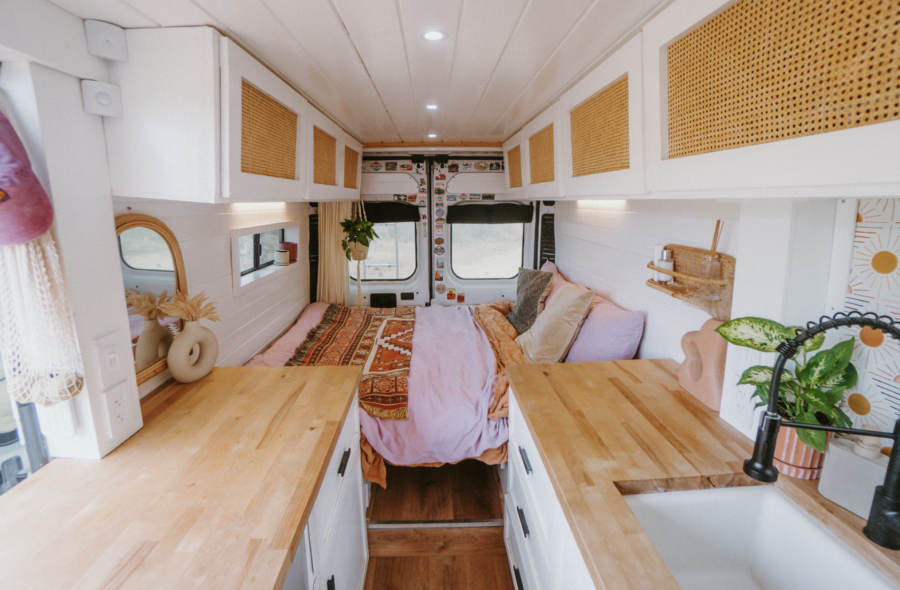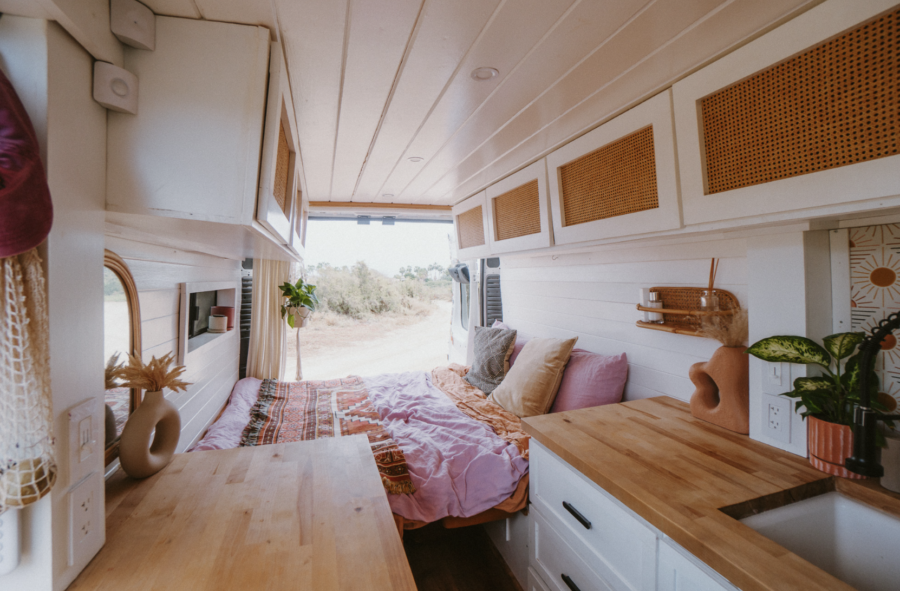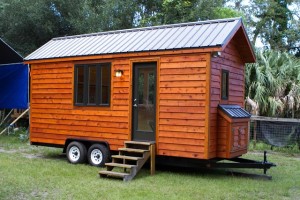This post contains affiliate links.
The biggest debates when converting a van seem to be 1) Should you install an indoor shower? and 2) Should you have a fixed bed or a convertible one? Blake and Tabby chose to maximize space and leave out the shower. They also chose a convertible bed that sets up as a U-shaped conversation area during the day.
They’re taking this fantastic ProMaster to visit all the National Parks and have no plans of quitting vanlife anytime soon. Because they’d sold most of their belongings and furniture before moving into the van, the space felt rather luxurious compared to eating ramen in their empty apartment! You can see why in the tour below.
Don’t miss other interesting tiny homes like this one – join our FREE Tiny House Newsletter for more!
Discover the Abundance of Counter Space in Their Impressive Van Conversion

Images via Tiny Home Tours
I just love the overhead cabinets!

Images via Tiny Home Tours
The bed converts to a U-shaped dinette when needed.

Images via Tiny Home Tours
VIDEO: Self-Built Camper Van for a National Parks Tour
Highlights
- Blake and Tabby opted to maximize space in their van conversion by forgoing an indoor shower.
- They chose a convertible bed that transforms into a comfortable U-shaped conversation area during the day.
- Their ProMaster van is their trusty vehicle of choice for exploring all the National Parks.
- The couple has no plans of quitting van life anytime soon and enjoys the freedom it offers.
- After selling most of their belongings, the van space felt luxurious compared to their previous empty apartment.
- Don’t miss the abundance of counter space showcased in their impressive van conversion.
- The overhead cabinets add a touch of functionality and storage to their mobile home.
- The convertible bed allows for flexibility, providing a cozy sleeping area and transforming into a dinette when needed.
- Don’t forget to watch the captivating video tour (above) of their self-built camper van, perfect for National Parks adventures.
- You can also follow the couple right here on Instagram.
Learn More:
Related Stories:
- Linda & Bill Retire in A Self-Built ProMaster Van
- Her ProMaster Van Conversion with a Murphy Bed
- DIY Ram Promaster with a Skylight
Our big thanks to Tiny Home Tours for sharing! 🙏
You can share this using the e-mail and social media re-share buttons below. Thanks!
‘If you enjoyed this you’ll LOVE our Free Daily Tiny House Newsletter with even more!
You can also join our Small House Newsletter!
Also, try our Tiny Houses For Sale Newsletter! Thank you!
More Like This: Tiny Houses | Van Life | Video Tours | Conversions | Couple Tiny House Living
See The Latest: Go Back Home to See Our Latest Tiny Houses
This post contains affiliate links.
Natalie C. McKee
Latest posts by Natalie C. McKee (see all)
- Urban Payette Tiny House with Fold Down Deck! - April 25, 2024
- Luxury Home Realtor’s Tiny House Life in Florida - April 25, 2024
- Handcrafted, Eco-Bohemian Tiny House with a Deck - April 25, 2024






Their enjoyment of their very nice van is contagious! So many nice features here — all the safety and security devices are smart and their kitchen looks to be very efficient. I, especially love their stove — two burners would be more than adequate for me — plus a small oven when needed — just the right size without taking too much space. As for the butcher block — I had them several years ago when they first became popular — and I wouldn’t ever want them again. They look great but aren’t practical for everyday kitchen use (unless there are some new methods for keeping them looking good)! All in all — nice endorsement for van living for sure!!
“I had them several years ago when they first became popular”
Butcher blocks actually go back centuries to China and have been popular in the states around since the last quarter of the 19th century. So not the first, like wood floors it’s just something that goes in and out of style. Though, it’s more common in homes now when it was previously mainly seen in restaurants, actual butcher shops, etc. except for the homes of chefs, etc.
However, something to understand about the modern version is that what most people call butcher block is just because of the appearance but aren’t actually built like traditional butcher blocks. Since, real butcher block is very expensive and people tend to use it for more decorative purposes these days.
A real butcher’s block is made with good hardwoods like maple, non-porous, using the more durable end grain and is no less than 1½ inches thick, can be much thicker. It is also no less than a 12-inch x 12-inch surface on up to counter top sizes.
In the end grain of a butcher’s block, the end of the wood fibers is exposed, making it resilient to damages such as cracks, scarring, and cuts. Some wood fibers will even go back to their original place, causing a healing effect over time.
So several forceful blows with a chopping blade will not scar the block while cutting through bones, and it is easier to clean as it is non-porous, and the wood won’t soak up blood and juices from the meat. It just takes a larger work area to handle butchering jobs such as chopping, deboning, quartering, and filleting. Thus Butcher blocks traditionally had a lot of mass.
Like a blacksmith and their anvil, the Butcher block was the equivalent for the butcher.
It’s just that much hard wood, quality build with end grain, etc. would get extremely expensive quick, with modern prices. You could basically buy a vehicle… So the cheaper ones don’t use as expensive woods, tend to keep the thickness/mass thin/low and typically won’t use the end grain. Making for a less durable surface but keeps the look at a much more affordable price.
Thus why, some people have taken to applying coats like epoxy, etc. for added durability and easier maintenance.
It’s also harder to get a real traditional butcher block because it’s much harder to get wood with the old growth density.
While the version you used was probably less durable and harder to maintain. It can still be maintained. It just requires more work if you want to keep it protected and easy to clean. Though, it is still considered a tool for the kitchen and like a chopping block, many consider it okay to have wear because it’s a tool you use and usually only worry about something really standing out and distracting. However, sanding, using card scrapers, etc. can smooth out the entire surface to make it fresh again.